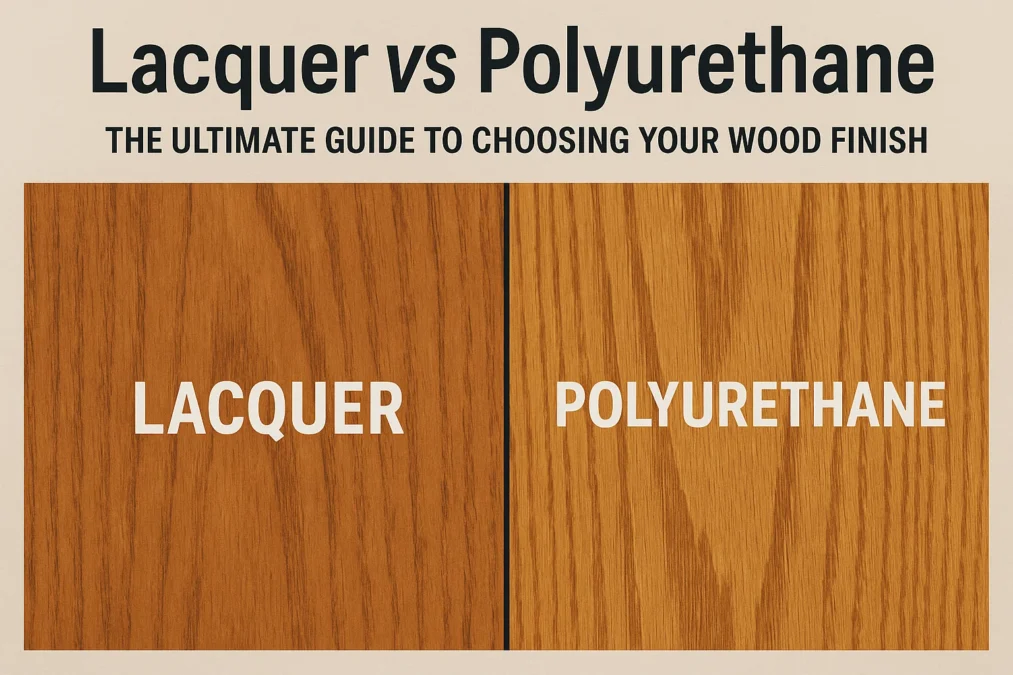Lacquer vs Polyurethane: You’ve poured your heart and soul into a woodworking project. You’ve selected the perfect wood, made precise cuts, and sanded everything to a silky smoothness. Now comes the final, crucial decision: the finish. This isn’t just about looks; it’s about protection, durability, and bringing out the wood’s inner character. For many woodworkers and DIYers, the debate quickly narrows down to two heavyweight champions: lacquer and polyurethane.
Both are incredibly popular, yet they represent two very different philosophies in wood finishing. Choosing between them can feel overwhelming, shrouded in myths and strong opinions from seasoned pros. Is one inherently better? The truth is, the “best” finish entirely depends on your project, your workspace, your skills, and your desired outcome. This comprehensive guide will cut through the confusion. We’ll dive deep into the chemistry, application, and real-world performance of lacquer and polyurethane, giving you the knowledge you need to make an informed choice with confidence. By the end, you’ll know exactly whether a lacquer or polyurethane finish is the right call for your next masterpiece.
Understanding the Basics: What Are We Actually Talking About?
Before we pit them against each other, it’s essential to understand what these finishes are at a fundamental level. While both create a protective shell, they achieve this in remarkably different ways.
Lacquer is a classic finish that has been used for centuries, though its modern formulations are far advanced. Traditional lacquer is made from shellac or synthetic resins dissolved in a powerful solvent blend. When you apply it, the solvents rapidly evaporate into the air, leaving behind a solid film of resin on the wood’s surface. This is known as a solvent-evaporation finish. It doesn’t cure through a chemical reaction with oxygen like some finishes; it simply dries as the liquids disappear. Modern nitrocellulose lacquer is the most common type you’ll find in aerosol cans or for spray gun application, prized for its incredible clarity and fast-drying properties.
Polyurethane, on the other hand, is a more modern invention. It’s classified as a reactive finish. Polyurethane is typically a two-part system (a base resin and a hardener) or a one-part product that cures through a chemical reaction with moisture in the air. This reaction creates long, cross-linked polymer chains that form an incredibly tough and durable plastic-like coating. Think of it as a liquid plastic that transforms into a solid shield. This curing process is what gives polyurethane its legendary resistance to water, heat, and physical abrasion, making it a go-to for high-traffic surfaces.
The Showdown: Key Differences Between Lacquer and Polyurethane
Now, let’s break down the head-to-head competition across the categories that matter most for your projects. Understanding these core differences is the key to making your choice.
Application Methods: Spray Can, Brush, or Wipe?
How you apply a finish is a huge practical consideration, especially for home hobbyists without a professional spray setup.
Lacquer is famously fast-drying. This is its greatest advantage for speed and its biggest challenge for application. Because it dries in minutes, brushing it on is very difficult for an amateur; it can lead to brush marks, lap lines, and a messy appearance. For this reason, lacquer is predominantly applied with a spray gun in a well-ventilated booth or with aerosol spray cans. Spraying allows for a thin, even coat that “melts” into the previous coat, creating a seamless, unified film. This process, called burn-in, is unique to lacquer and allows for easy repairs and a flawless surface.
Polyurethane is much more user-friendly for the beginner. It dries slowly, often taking hours to become touch-dry and overnight to recoat. This slow drying time gives you a long “open time” to brush it on carefully, working out any bubbles or brush strokes for a smooth finish. It can be applied with a high-quality natural bristle or synthetic brush, a foam applicator, or even wiped on with a rag for a very thin coat. While it can be sprayed, its thicker viscosity and slower drying time make brushing the preferred method for most DIY applications.
Drying and Curing Time: A Race Against the Clock
This is perhaps the most dramatic difference between the two finishes and a major deciding factor for professionals on a deadline.
Lacquer wins the speed race, hands down. A coat of lacquer can be dry to the touch in 10-15 minutes and ready for a light sanding and recoating in under an hour. You can easily apply three or four coats in a single afternoon. This makes it incredibly efficient for production work. However, it’s crucial to remember that “dry” and “cured” are not the same. While the solvents flash off quickly, the film can continue to harden and reach its full chemical stability over several days.
Polyurethane is the tortoise in this race. It can take 4-6 hours to be dry to the touch and requires a full 24 hours or more between coats for proper adhesion. The full curing process—where it reaches its maximum hardness and durability—can take weeks. This means a project finished with polyurethane needs to be handled with care and kept in a low-traffic area for a significant period before it can be put to hard use. The trade-off for this patience is an incredibly resilient final product.
Durability and Protection: Which Finish is Tougher?
When it comes to protecting your wood from the rigors of daily life, both finishes are excellent, but they excel in different areas.
Polyurethane is the undisputed champion of hard-use surfaces. Its cross-linked polymer structure creates a flexible yet incredibly tough barrier that is highly resistant to water, chemicals, heat, and abrasion. This is why it’s the top recommendation for kitchen tables, hardwood floors, bar tops, and children’s furniture. It can handle spills, scratches, and heavy use better than almost any other consumer-grade finish. Think of it as the heavy-duty body armor for wood.
Lacquer is durable but in a different way. It forms a very hard, rigid film that is resistant to scratches and is excellent at resisting water and alcohol (especially in its pre-catalyzed or post-catalyzed forms). However, because it is more brittle than polyurethane, it can be more susceptible to cracking or chipping under heavy impact. Its resistance to heat and strong solvents is also lower. For a piece of fine furniture like a cabinet, desk, or bookshelf that won’t see constant abuse, a lacquer finish offers more than enough protection and a superior look.
Appearance and Aesthetics: The Look and Feel
The ultimate goal of any finish is to enhance the natural beauty of the wood. This is where the debate gets subjective and where lacquer often steals the show.
Lacquer is renowned for its crystal-clear, depth-enhancing qualities. It adds minimal color, typically just a slight warm amber tone (if any), allowing the natural color and grain of the wood to shine through authentically. Because each spray coat melts into the last, it builds into a perfectly continuous film that looks like a layer of glass sitting on top of the wood. This results in a high-gloss, professional-looking finish that is hard to replicate with other products. It can, of course, be satinized to any sheen level.
Polyurethane, especially oil-based polyurethane, tends to add a more significant warm, amber-orange tone to the wood. This can be desirable on woods like pine or oak but can muddy the appearance of lighter woods like maple or ash. Water-based polyurethane has solved this problem by being almost perfectly clear, but it can sometimes leave a slightly plastic or milky look on darker woods. While it can be built to a very smooth finish, it often doesn’t achieve the same depth and clarity as a well-applied lacquer. The brushed application can also sometimes leave subtle brush marks or texture.
LVP vs Engineered Hardwood: The Ultimate Guide to Choosing Your Perfect Floor
Safety and Ventilation: Handling with Care
Your personal safety and workspace environment are non-negotiable factors when choosing a finish.
Lacquer is the more hazardous material to work with. Its solvents are volatile organic compounds (VOCs) that are highly flammable and produce strong, potentially harmful fumes. Applying lacquer requires a serious commitment to safety: a professional-grade respirator with organic vapor cartridges, explosive-proof spray booth ventilation, and proper skin protection are absolute musts. It is not a finish to be used casually in a basement or garage without extensive precautions.
Polyurethane is generally safer but still requires care. Oil-based polyurethane contains solvents and VOCs that produce noticeable fumes, necessitating good ventilation and a respirator. Water-based polyurethane has a much lower VOC content, with minimal odor, making it far more suitable for indoor use with just an open window. However, even water-based products can contain other chemicals, so reading the safety data sheet and using basic protection like gloves and goggles is always wise.
Repair and Maintenance: Fixing the Inevitable
No finish lasts forever. Eventually, a piece will get scratched, dented, or worn, and how you fix it depends on the finish.
Lacquer is famously easy to repair. Because new coats chemically “burn-in” and dissolve the existing coats, you can spot-repair a scratch by lightly spraying the area. The new lacquer will melt into the old, seamlessly blending the repair without any visible lines. This makes it a fantastic choice for antique restoration or any piece that might need touch-ups down the line.
Polyurethane repairs are more challenging. Since it forms a cured plastic film, new coats will not melt into old ones. To repair a scratch, you often have to lightly sand the entire surface to create a mechanical bond for the new coat. If the scratch is deep, you might need to sand through the entire finish layer and start over. This makes spot repairs virtually impossible without seeing a “witness line” where the new finish overlaps the old.
Making the Right Choice: Lacquer or Polyurethane for Your Project?
So, with all this information, how do you decide? Let’s match the finish to the project.
Choose Lacquer for:
- Fine Furniture: Cabinets, display cases, desks, and chairs where a superior, professional-looking clarity and depth are the top priority.
- Musical Instruments: Guitars and violins where a thin, hard, and resonant finish is required.
- Production Work: When you need to apply multiple coats and complete a project in a single day.
- Antiques and Restoration: Where the ability to perform seamless, invisible repairs is critical.
- You have a spray setup and a safe, ventilated space.
Choose Polyurethane for:
- High-Traffic Floors: Hallways, living rooms, and kitchens where extreme abrasion resistance is needed.
- Dining Tables and Kitchen Counters: Surfaces that will face constant exposure to water, heat, spills, and chemicals.
- Outdoor Furniture: Specifically, spar urethane, which contains UV blockers and is more flexible to handle wood movement.
- Children’s Toys and Furniture: Where maximum durability and non-toxicity (once fully cured) are paramount.
- You are a DIYer working at home with brushes and basic ventilation.
Beyond the Binary: Other Finishes and Considerations
While the lacquer vs polyurethane debate is central, it’s worth noting they aren’t the only options. Shellac offers a beautiful, natural, and non-toxic option but lacks durability. Pure oil finishes like tung oil or linseed oil offer a natural feel but little protection. Modern hardwax oils like Osmo offer a great middle ground with good protection and a natural look. Often, professionals will use a combination, like sealing with shellac and then top-coating with lacquer for durability, to get the best of all worlds.
Conclusion
The battle between lacquer and polyurethane doesn’t have a single winner. Instead, it has two champions, each reigning over different domains. Lacquer is the artist’s choice, offering unparalleled beauty, speed, and a flawless glass-like finish for projects where aesthetics are paramount. Polyurethane is the workhorse, providing legendary durability and protection for surfaces that must withstand the tests of daily life and time.
Your choice ultimately hinges on your priorities. Are you seeking the clearest, most professional appearance for a showpiece, and do you have the equipment to apply it safely? Then lacquer is your finish. Or is your top concern building an indestructible shield for a kitchen table, and will you be applying it with a brush? Then polyurethane is the clear choice. By understanding their strengths and weaknesses, you can move beyond the debate and confidently select the perfect finish to make your woodworking project truly complete.
Frequently Asked Questions: Lacquer vs Polyurethane
Can I apply polyurethane over an existing lacquer finish?
It is generally not recommended to apply polyurethane directly over lacquer. Because lacquer is a solvent-based finish, the chemicals in a new coat of oil-based polyurethane can react with it, causing it to wrinkle, crack, or never properly cure. If you must do this, you must first seal the lacquer with a barrier coat of dewaxed shellac (like Zinsser SealCoat). This creates an inert layer that prevents the two reactive finishes from interacting. Always test this process on a small, inconspicuous area first.
Is a lacquer finish more expensive than a polyurethane finish?
The cost can be similar for the materials themselves, but the total cost of a lacquer finish is often higher when you factor in the necessary equipment. You can brush a polyurethane finish with a $10 brush. To properly apply lacquer, you ideally need a HVLP spray gun ($100+), an air compressor ($200+), and a serious ventilation or respirator system ($50+). Without this equipment, achieving a professional-looking brushed lacquer finish is extremely difficult, which is why it’s often seen as a more “professional” option.
Which finish is better for a kitchen table: lacquer or polyurethane?
For a kitchen table, which endures spills, heat, scratches, and heavy use, polyurethane is almost always the better choice. Its superior resistance to water, chemicals, and abrasion makes it the more durable option for this specific application. While a catalyzed lacquer can be very tough, a good quality oil-based or water-based polyurethane will provide a longer-lasting, more resilient surface that can handle the demands of a daily-use kitchen table.
Does lacquer yellow over time like polyurethane does?
Most clear finishes will amber slightly with age due to UV exposure, but they do so at different rates. Traditional nitrocellulose lacquer is designed to be very clear but can develop a warm amber patina over many decades, which is often desirable on antiques. Oil-based polyurethane yellows significantly and much faster, which is noticeable on light woods. Water-based polyurethane and acrylic-modified lacquers are formulated to be non-yellowing and will remain clear for far longer, making them ideal for white paints or light woods like maple or ash.
Can I use lacquer on outdoor furniture?
No, standard lacquer is not suitable for outdoor use. It lacks the UV inhibitors to prevent breakdown from sunlight and is not flexible enough to handle the expansion and contraction of wood with changing humidity and temperature. It will quickly crack, peel, and fail when exposed to the elements. For outdoor projects, you must use a finish specifically designed for exterior use, such as spar urethane (a more flexible type of polyurethane), marine varnish, or a dedicated outdoor oil.
Comparison Table: Lacquer vs Polyurethane
| Feature | Lacquer | Polyurethane |
|---|---|---|
| Base Type | Solvent-based (usually) | Oil-based or Water-based |
| Curing Method | Solvent Evaporation | Chemical Reaction (with air/moisture) |
| Application | Primarily Spray | Brush, Wipe, or Spray |
| Drying Time | 10-30 minutes (to touch) | 2-6 hours (oil-based), 30-60 min (water-based) |
| Curing Time | Several days (full hardness) | Several weeks (full hardness) |
| Durability | Hard, but can be brittle; good scratch resistance | Extremely tough, flexible; excellent abrasion/impact resistance |
| Water Resistance | Good (Excellent with catalysts) | Excellent |
| Heat Resistance | Fair | Good |
| Appearance | Crystal clear, high-depth, professional gloss | Can be clear (water-based) or amber (oil-based); can look plastic-like |
| Repairability | Excellent (new coats melt into old) | Difficult (requires sanding for recoating) |
| VOC / Fumes | Very High (requires serious ventilation) | High (oil-based), Low (water-based) |
| Best For | Fine furniture, cabinets, musical instruments, rapid production | Floors, tables, countertops, outdoor furniture, DIY projects |
Quotes
“Lacquer is the finish of choice for the professional looking for speed and a flawless glass-like appearance, while polyurethane is the guardian of family homes, offering unparalleled protection against the chaos of daily life.” — Anonymous Furniture Maker
“The difference is in the cure. Lacquer dries, polyurethane cures. One is a race, the other is a marathon. Both get you to the finish line, but the journey and the final result are worlds apart.” — Finishing Expert



